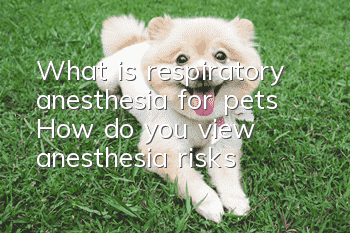What is respiratory anesthesia for pets? How do you view anesthesia risks?

Nowadays, the overall awareness and technical level of the domestic pet medical industry have been greatly improved. Most hospitals and clinics provide respiratory anesthesia. So, does this mean it is very safe and can be worry-free?
1. Why do we need anesthesia?
Pets not only need surgery when they are sick or injured, but they also often face surgical procedures. The most common surgery is sterilization. Some dogs also need tail docking, ear pricking, teeth cleaning and other cosmetic surgeries. Regardless of the size of the operation, anesthesia is required. At this time, the doctor will tell us that there are risks in anesthesia and we need to sign. We can't help but feel a little nervous and scared. Why is there risk in even a minor operation?
2. What are the classifications of anesthesia?
Anesthesia can be divided into local anesthesia and general anesthesia, and general anesthesia is divided into injection anesthesia and inhalation anesthesia. Generally speaking, injection anesthesia has the greatest risk, while inhalation anesthesia is relatively safer. Local anesthesia is the safest. "Spinal anesthesia" widely used in human medicine is also a type of local anesthesia, but it is rarely used in veterinary clinical practice because this kind of anesthesia is a semi-general anesthesia, the brain is awake, and the upper limbs and head can also move. Dogs have no human control, and in most cases they will not obediently cooperate with the doctor's surgery. Therefore, most pet surgeries are performed under general anesthesia.
3. What is general anesthesia?
It means that anesthetics enter the body through respiratory inhalation, intravenous or intramuscular injection, resulting in temporary suppression of the central nervous system. The clinical manifestations are loss of consciousness, loss of systemic pain, amnesia, reflex inhibition and skeletal muscle relaxation. The degree of depression to the central nervous system is related to the drug concentration in the blood and can be controlled and adjusted. This suppression is completely reversible, and all aspects of body function return to normal after the drug is metabolized or eliminated from the body.
IV. What are the risks of general anesthesia?
1. Cardiovascular problems such as bradycardia, arrhythmia, and cardiopulmonary arrest. Older pets are more likely to develop these problems.
2. Respiratory obstruction and pulmonary edema. Some specific breeds such as Bulldogs, Chow Chows, Mynas and other breeds are very prone to this problem due to their physiological structure.
3. Acute renal failure and anesthesia can be very dangerous for pets with chronic renal insufficiency.
4. Post-anesthesia febrile hyperthermia, this disease is hereditary and mostly occurs in muscular male dogs. Symptoms include fever, tachycardia and death 30 minutes to several hours after inhalation anesthesia.
5. How to reduce this risk?
1. The first thing is to choose a pet hospital with advanced equipment and complete procedures. The hospital has enough doctors, and it is safer to have someone responsible for anesthesia monitoring during the operation.
2. Choose respiratory anesthesia. Respiratory anesthesia is also gas anesthesia. Anesthetic drugs enter the body through gas. The anesthetic effect is fast, the metabolism is fast, and it has little inhibitory effect on cardiovascular and respiratory tracts. It is now recognized as the safest anesthesia method. In contrast, injection anesthesia involves injecting drugs into the body, which may have a certain inhibitory effect on respiratory and cardiovascular effects. Injection anesthesia drugs are also divided into imported anesthetics and domestic anesthetics. Nowadays, domestic anesthetics are not very safe and have been basically eliminated. Although imported anesthesia is highly safe, due to restrictions on national approval, they can only enter the country through purchasing agents and other means, and the supply of goods is limited. Stablize.
3. Relevant examinations must be carried out before surgery. We will not be aware of many potential diseases because dogs or cats have no obvious symptoms and can only detect problems through instruments and equipment. Before surgery, doctors will recommend checking biochemistry, blood routine and electrocardiogram. This is definitely not to charge more, but to increase the safety of anesthesia. The main organs examined include the heart, kidneys, etc. If chronic heart and kidney diseases are not discovered, the risk will be difficult to rescue after anesthesia.
4. Follow the doctor’s instructions carefully. The doctor will tell you not to eat for 12 hours and not drink for 8 hours before anesthesia. This must be followed and cannot be left to chance. Once vomiting occurs during anesthesia, vomitus can lead to death by suffocation.
6. Correctly view anesthesia risks
Anesthesia is risky, but it must be treated scientifically and rationally and operated according to procedures. This risk is actually very low. Even a hospital with a large outpatient volume may encounter anesthesia accidents only once or not at all in several years. The surgery that needs to be done must be done in time, and you cannot stop eating because of choking.
Sourced from Pet Guide Network
- What to do if your dog’s nose is dry
- Which color of fawn dog is the most expensive? Fawn dog price!
- How to correct your dog’s food picking
- How to remove tear stains from dog’s eyes?
- What should you pay attention to when choosing pet food?
- How to train an Alaskan Malamute to walk well
- Samoyed age and weight comparison chart
- How to choose a good Samoyed puppy?
- What to do if your puppy doesn’t want to drink water
- Feeding of 2-month-old puppies



